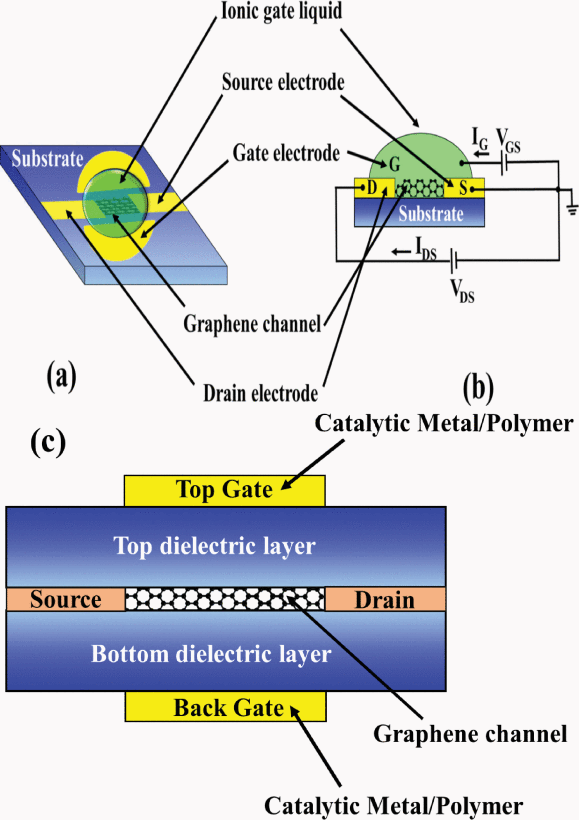Fabrication Strategies and Measurement Techniques for Performance Improvement of Graphene/Graphene Derivative Based FET Gas Sensor Devices: A Review
In the ever-expanding arena of gas sensor research, the most recent inclusions are graphene or graphene derivative, viz. reduced graphene oxide (rGO) field-effect transistors (FET). They have enormous potential to detect a wide variety of oxidizing and reducing target species with high sensitivity.
Single-layer or multilayer graphene nanosheets are ultrathin and have a large surface-to-volume ratio, high electron mobility, and high saturation velocity. They show a significant change in channel conductance upon exposure to even a few molecules of a broad spectrum of oxidizing and reducing gaseous. These properties make the single-layer or multilayer graphene nanosheets an ideal channel material for developing field-effect transistor (FET) gas sensor devices. While high transconductance gain and high saturation drift velocity ensure high sensitivity and high dynamic range of the gas sensor, ultrahigh mobility ascertains fast transient characteristics (response/recovery time).
Graphene FET (G-FET) shows ambipolar current transport resulting in a 'V-shaped drain current (IDS) versus gate voltage (VGS) characteristics where the minimum drain current portion is known as 'Dirac Point' (charge neutrality point or CNP). Due to their highly conducting nature, G-FETs are 'normally ON' devices. With exposure to gaseous target species, a change in drain current as a function of VGS or VDS is observed due to a change in channel conductivity. Moreover, a shift in the 'Dirac point' is also observed.
However, G-FET with a 'pristine or clean graphene' channel is usually insensitive to target gases due to its chemically inert nature. Therefore various surface modification or functionalization techniques are generally required. Considering the derivative of graphene as an alternative, graphene oxide-based FET (GO-FET) was demonstrated. However, a trade-off between the reduced conductivity aspect and functional group abundance eventually projected GO-FET as an unsuitable candidate for the gas sensor family. On the contrary, rGO-FET gained significant mileage in the same field owing to its synergistic features without compromising the basic advantages of G-FET.
The researchers have adopted various strategies during fabrication and measurement to improve the performance index, like sensitivity/response magnitude, response time/recovery time, selectivity, baseline drift, voltage/power requirement, etc., of graphene/rGO-FET gas sensor devices. These strategies can broadly be classified as; (i) fabrication/device level optimization and (ii) operational/measurement technique improvisation.
In the first category, improvement of various sensing parameters of graphene/rGO FET through functionalization/surface modification/doping of channel, use of novel gate dielectric/ gate material, and exploration of innovative device configurations (ionic top gate, single back gate or dual gate) have been discussed.
In the second category, optimized gate biasing, AC phase-sensitive measurement, quasi-static/real time conductance measurement, and low-frequency noise spectra based measurement techniques have been elucidated.
In the critical review and comparison of the fabrication strategies and measurement techniques for performance improvement of Graphene/Graphene Derivative based FET, the experts concluded that selectivity, long-term stability, and device-to-device variation are still challenging issues. These must be addressed and resolved before the practical or commercial applications of GO/rGO-FET gas sensor devices.




